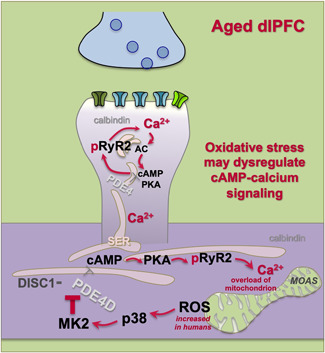Figure 6.

Schematic illustration of the hypothesis that elevated ROS (oxidative stress) in dysmorphic mitochondria can induce p38‐MK2 signaling, which can dysregulate calcium signaling by unanchoring and inhibiting PDE4s, which in turn can create calcium overload of mitochondria, perpetuating a vicious cycle. Calcium dysregulation and p38 signaling can both contribute to the phosphorylation of tau. Higher rates of energy metabolism in human brain may increase these factors in humans, propelling AD pathology. MOAS, mitochondria‐on‐a‐string, an abnormal phenotype seen in AD and aged monkey association cortex; AD, Alzheimer's disease; ROS, reactive oxygen species
